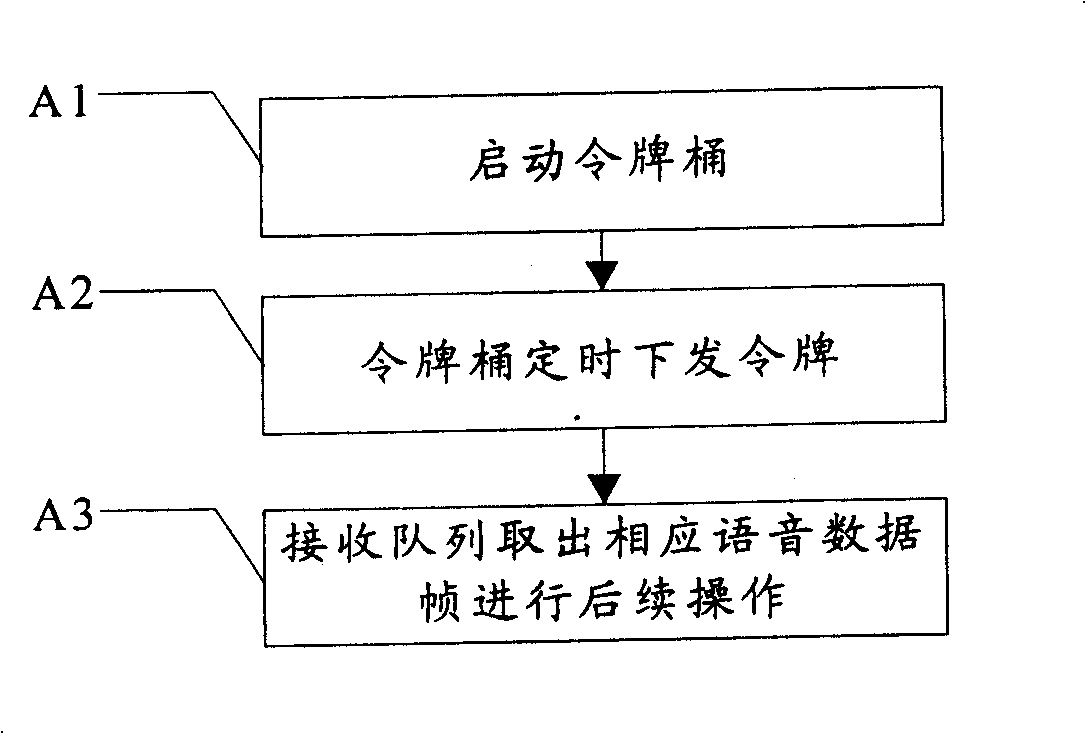Speech data frame receiving method and terminal, wireless packet network gate and system
A wireless packet network, voice data technology, applied in the field of communication, can solve the problems of users unable to talk normally, unstable voice quality of VOIP network, voice quality degradation, etc., to improve the quality of VOIP voice communication, suppress delay jitter, and suppress jitter Effect
- Summary
- Abstract
- Description
- Claims
- Application Information
AI Technical Summary
Problems solved by technology
Method used
Image
Examples
Embodiment 1
[0032] Embodiment 1. A method for receiving a voice data frame, the process is as follows image 3 shown, including:
[0033] A1. Start the token bucket that controls the voice data frame receiving queue; the activation conditions of the token bucket can be set according to the actual situation. The token bucket can be started when voice data is received, or after the received voice data frame is detected. The time interval between is unstable, and there is a deviation from the sending time interval, that is, the token bucket is started when delay jitter occurs;
[0034] A2. The token bucket issues tokens at a set time interval; in this paper, the time interval between the issuance of two adjacent tokens is called a token interval, in order to ensure the consistency of the voice rate between the receiving side and the sending side The token interval is generally consistent with the sending time interval of the sending side, which is 10 to 50 milliseconds, usually 20ms; of cou...
Embodiment 2
[0057] Embodiment two, a kind of receiving method of speech data frame, flow process is as follows Figure 5 shown, including:
[0058] B1, start the token bucket when the receiving queue receives the first voice data frame; this example adopts the condition of starting the token bucket with the arrival of the first voice data frame;
[0059] B2. Issue the first token at half the token interval after the start of the token bucket; different from the additional time delay naturally generated by the deferred issuance of the token in Embodiment 1, in this example, when the token bucket is started After that, an additional delay is automatically set. Of course, this is the delay jitter suppression range of the current token bucket. When the token interval is 20ms, it is appropriate to set this suppression range between 5 and 25ms. Considering The general jitter of the transmission network and the impact of additional delay on the real-time performance of voice, in this example, s...
Embodiment 3
[0069] Embodiment 3, a terminal, such as Figure 6 As shown, including receiving module 1, voice conversion module 2, token bucket control module 3;
[0070] The receiving module 1 receives the voice data frame sent by the network side, and sends a voice data frame to the voice conversion module 2 successively after receiving the token issued by the token bucket control module 3;
[0071] The token bucket control module 3 issues a token to the receiving module 1 at a set time interval;
[0072] Voice conversion module 2 analyzes and converts voice data frames received.
[0073] The terminal provided in this embodiment can apply the jitter suppression control strategy provided in Embodiment 1 or 2 to control the received voice data frames.
PUM
 Login to View More
Login to View More Abstract
Description
Claims
Application Information
 Login to View More
Login to View More - R&D
- Intellectual Property
- Life Sciences
- Materials
- Tech Scout
- Unparalleled Data Quality
- Higher Quality Content
- 60% Fewer Hallucinations
Browse by: Latest US Patents, China's latest patents, Technical Efficacy Thesaurus, Application Domain, Technology Topic, Popular Technical Reports.
© 2025 PatSnap. All rights reserved.Legal|Privacy policy|Modern Slavery Act Transparency Statement|Sitemap|About US| Contact US: help@patsnap.com



